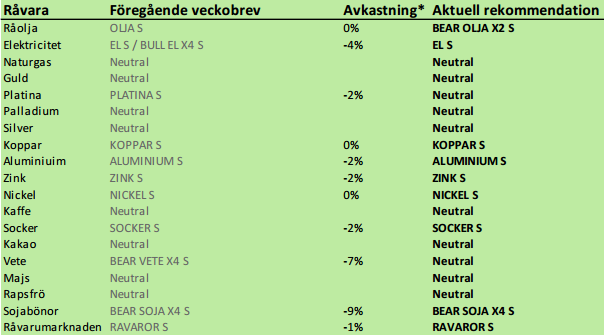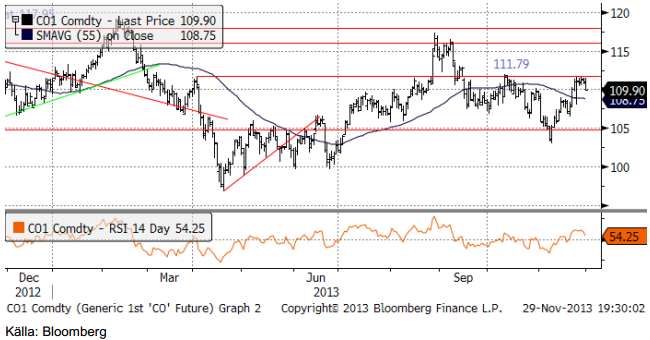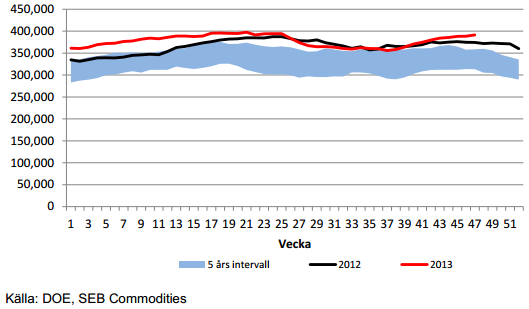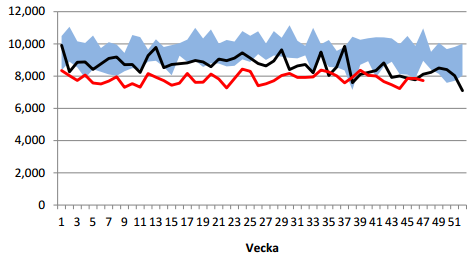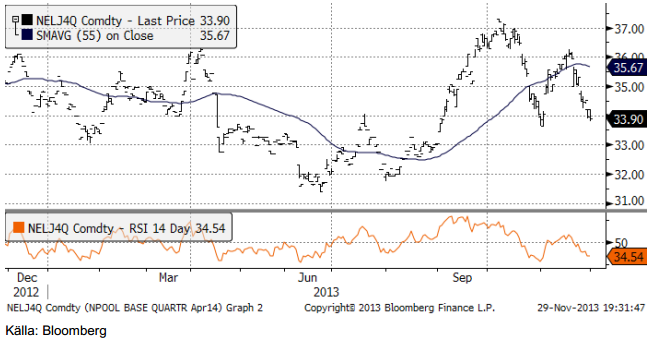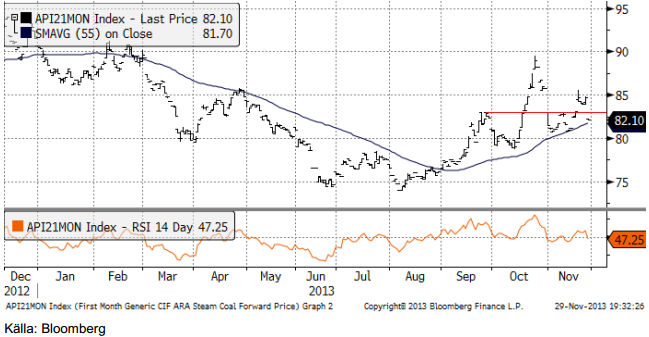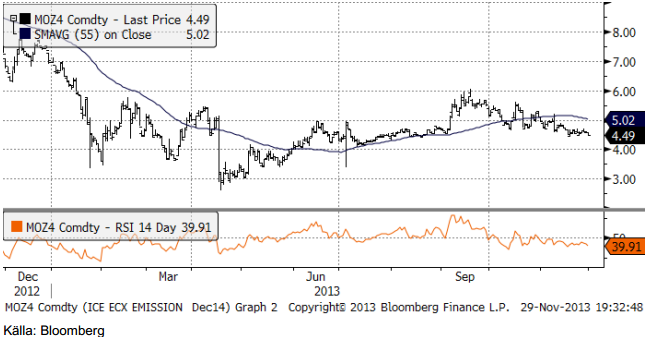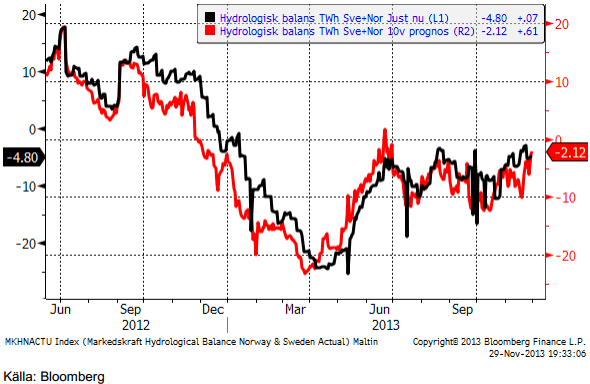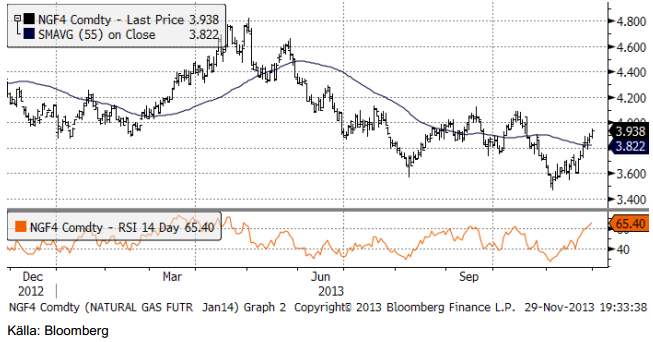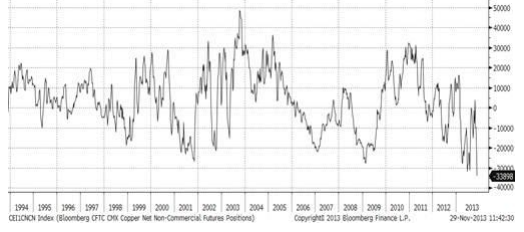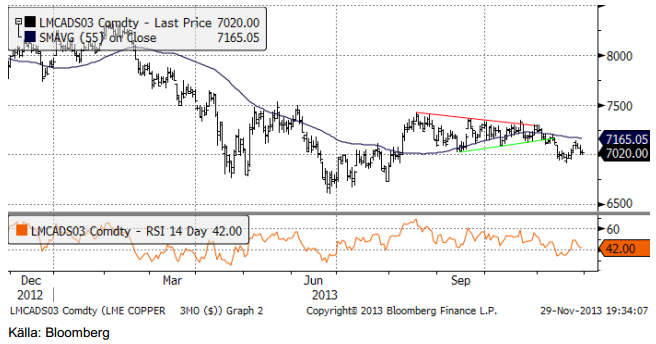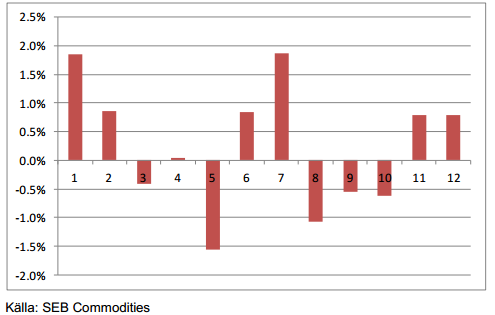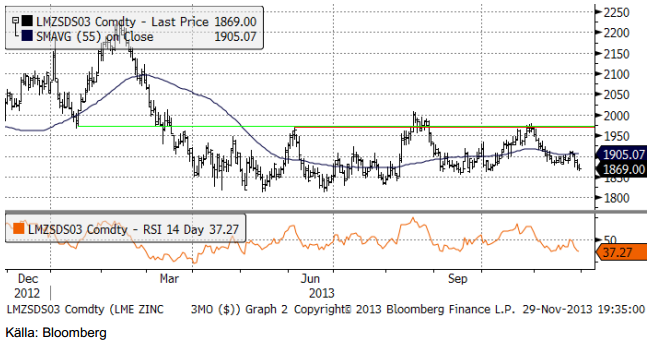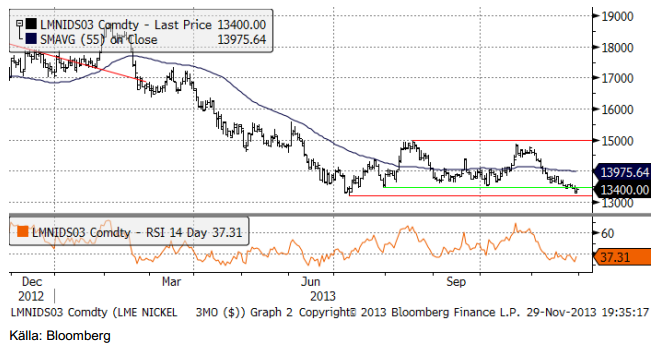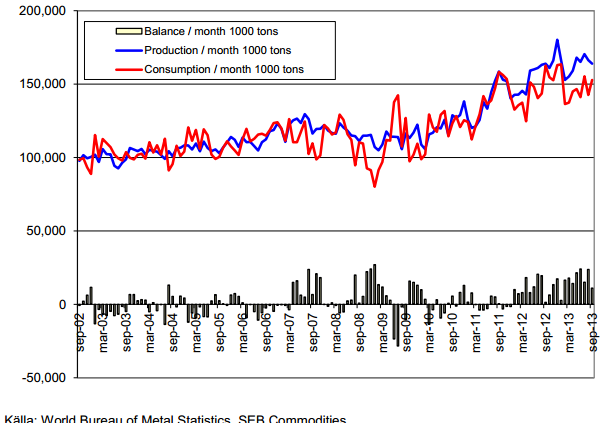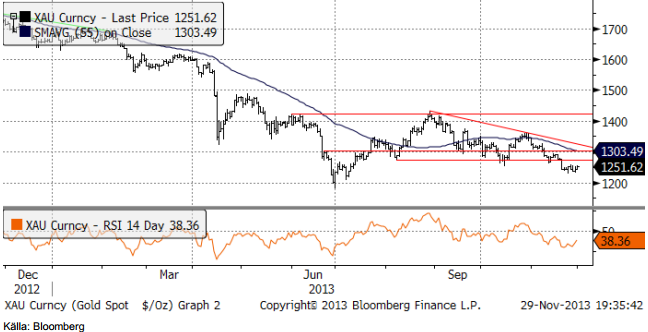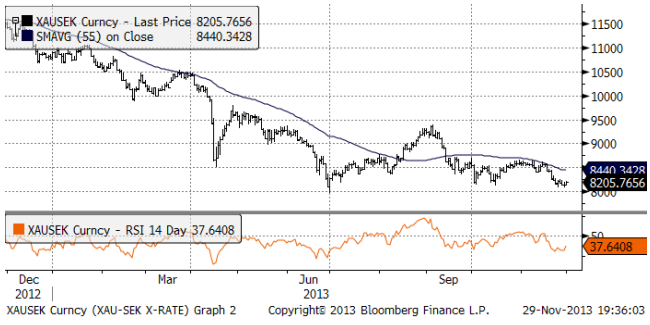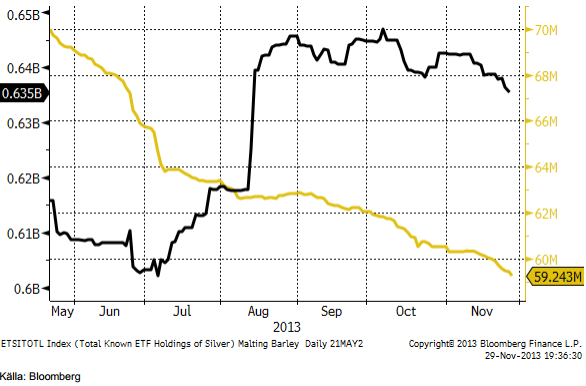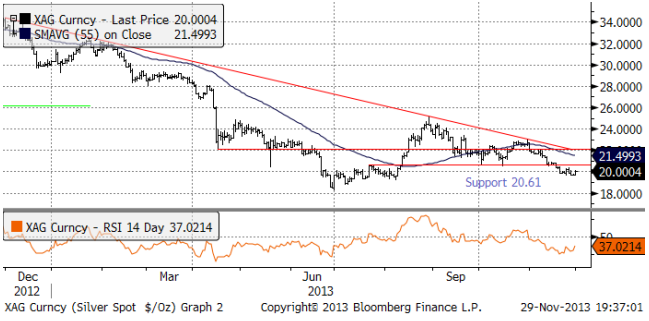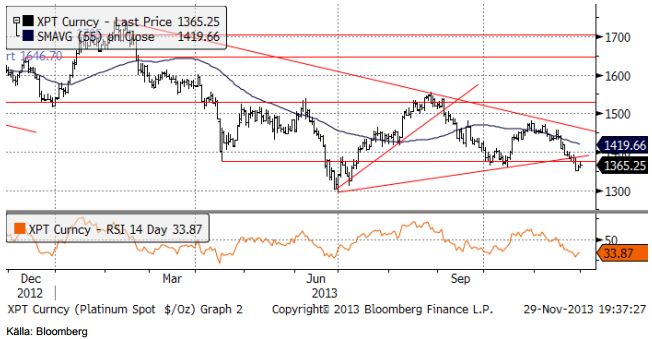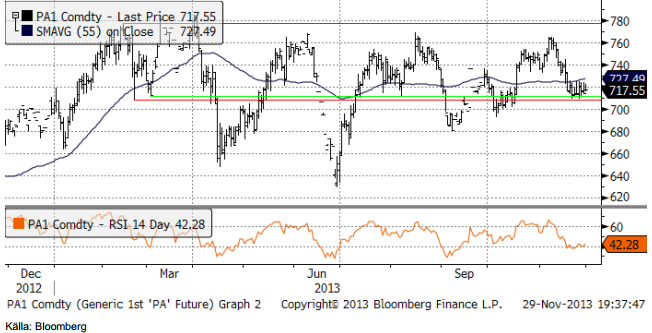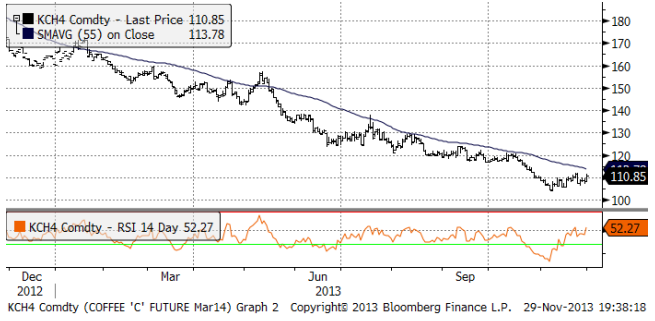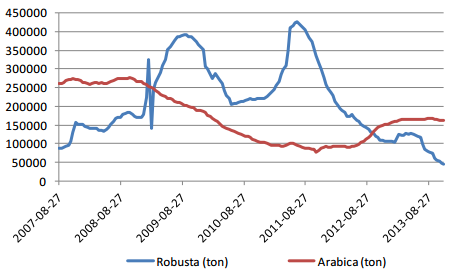Analys
SEB – Råvarukommentarer, 2 december 2013

Rekommendationer
*) Avkastningen anges för 1:1 certifikaten där både BULL och 1:1 certifikat är angivna.
Råolja – Brent
Oljepriset gick hela vägen upp till det gamla tekniska motståndet på 111.79 dollar per fat, innan det vände ner igen. SEB har uppdaterat sin prognos för oljepriset. Både för det första kvartalet och det andra nästa år, tror bankens oljeanalytiker på ett pris på 100 dollar per fat. De faktorer som bidrar till ett lågt pris är den stadigt ökande produktionen i USA, som innebär att mer olja blir kvar på världsmarknaden i kombination med fortsatt, förhållandevis, låg tillväxt i tillväxtländer.
EIA kunde i veckan meddela att bensinpriset i USA var det lägsta inför Thanksgiving-helgen på tre år. Förr i tiden ansågs ett lågt oljepris vara en drivkraft för tillväxt och det kanske är därför som USA – med såväl billig olja som ännu billigare naturgas drar ifrån resten av världen just nu. EU-28 pekades i veckan ut av chefen för International Energy Agency som i strykläge vad gäller tillväxt pga energipriser som är ca tre gånger så höga som i USA – och att detta är helt politiskt orsakat.
Priset på olja är nu så högt att vi inte längre kan rekommendera en köpt position i olja, utan går över till säljrekommendation. Den som vill kapitalisera på det, kan placera i BEAR OLJA X2 S med 2 gångers daglig hävstång eller BEAR OLJA X4 S med 4 gångers daglig hävstång – dvs en ganska hög risknivå.
I onsdagens DOE-rapport steg råoljelagren återigen och ligger nu som vi ser på rekordnivåer för säsongen.
Lagerökningen i USA har hänger delvis ihop med lite högre import för en månad sedan – vilket är en typisk uppladdning inför Thanksgiving-helgen.
Vi tycker alltså att priset på olja är för högt i dag och rekommenderar att man tar hem vinster på OLJA S och kortsiktigt går in i något av våra BEAR-certifikat. SEB:s certifikat på olja har inte bara lägre avgifter än något annan emittents utan också lägre skillnad mellan köp- och säljkurs.
Elektricitet
Certifikatet byter nu kontrakt från vinterkontraktet kvartal 1 till vår/försommarkontraktet kvartal 2. I diagrammet nedan ser vi den historiska prisutvecklingen på kvartal 1-kontraktet. Priset har rekylerat ner på förbättrad hydrologisk balans.
Kärnkraften i det nordiska börsområdet gick på 11 reaktorer, 82% av installerad kapacitet. Fredagens väderleksprognos visar på lägre genomsnittlig temperatur i veckan som kommer: -0.2C mot tidigare 0.2C prognosticerat. Normalt är 1.4C, så det är något kallare än normalt.
Enligt Markedskrafts prognosmodell ligger vattenkraften på +0.3 TWh över normalt om två veckor.
Nedan ser vi priset på energikol, den närmaste månadens leveranstermin. Priset steg successivt till 85 dollar, men föll kraftigt i torsdags och stängde veckan på 82.10 dollar / ton. Att marknaden inte orkade ta sig upp till föregående topp på 90 dollar, utan stannade på 85 dollar, får anses vara ett svaghetstecken.
Prisutvecklingen på utsläppsrätter fortsätter att dala sakta. Omsättningen var dock mycket hög i veckan som gick.
Hydrologisk balans ser vi nedan. Både den aktuella och 10-veckors prognos ligger strax under normala nivåer.
Vi rekommenderar köp av EL S.
Naturgas
Naturgaspriset i USA har handlats upp på det kalla vädret. Liksom i Norden, har det varit kallt i USA. Nedan ser vi januari-kontraktet.
Metaller
Den första delen av förra veckan kan bara beskrivas som väldigt tråkig. Kursrörligheten är på den lägsta nivån på flera år. Låga volatiliteter är ett fenomen som delas av de flesta finansiella marknader och är inte unikt för metallmarknaderna. Den här veckan var kursrörelserna mindre än vanligt – fram till onsdagens eftermiddag. USA var stängt på torsdagen för Thanksgiving. Vad som kan ha börjat som en likvidering av positioner inför helgen, startade en rask prisnedgång. Priserna gick ner med 1 – 2% i basmetallerna i en annars lugn marknad. Dollarn var lite svagare då och aktierna lite starkare, så det går inte att förklara prisrörelsen med de vanligaste faktorerna. Det gick inte heller att hitta någon annan förklaring.
”Non-commercials” i CFTC:s värld, dvs ”spekulanter” är extremt sålda terminer på basmetaller just nu, vilket historiskt har visat att marknaden är känslig för ”short covering”. Positionen i Comex terminskontrakt på koppar visar att non-commercials är nettosåld 35,000 kontrakt. Det är den största negativa positionen sedan 1993 och så långt bakåt informationssystemet Bloomberg har data. Vi tror att det ser likadant ut i andra basmetaller, som vi inte har CFTC-data på eftersom de handlas på den engelska börsen LME och alltså inte rapporterar positioner till det amerikanska CFTC.
Från en teknisk synvinkel ligger koppar och zink fortfarande över de lägsta priserna från sommaren, medan nickel ligger nära botten. Aluminium sticker ut genom att nu handlas på fyra års lägsta pris de senaste två dagarna. Vi tror att marknaden är överdrivet såld och tillflöde av nya säljare för att på riktigt trycka ner priset ytterligare. Vi håller fast vid åsikten att marknaden diskonterar en allt för pessimistisk framtid. Vi tror att det finns utsikter för en ordentlig rekyl uppåt innan nyår. Den säsongsmässigt starka perioden ligger framför oss. December / januari brukar vara starka månder vad gäller priset.
Nedan ser vi non-commercials nettoposition i Comex-koppar-terminer:
Net non-commercial position Comex Copper
Koppar
Koppar är just nu inte i fas med resten av basmetallgänget. Trots vad en teknisk analytiker skulle säga är en tydlig säljsignal efter utbrottet från triangelformationen för ett par veckor sedan, handlas koppar starkare än de övriga basmetallerna. Om man tar hänsyn till att spekulanterna på rekordhög nivå tycker att kopparpriset är säljvärt, är kopparprisets styrka ännu märkligare. De flesta marknadskommentatorer pekar på ”det ökade utbudet” som det huvudsakliga skälet till det negativa sentimentet kring metallen. Lagren vid börserna uppvisar tillbakavisar dock detta.
Lagren vid LME har sedan toppen på 675,000 ton sjunkit till 424,000 ton. Det är en minskning med 38%. Mest material har levererats ut från lagerhus i Malaysia. Materialet antas ha gått till Kina, men det finns (som vanligt) rykten om att det har parkerats någon annanstans (Vietnam talas det om). Vad som talar emot detta, är att det är en stadig minskning av LME-lagren och inte enskilda, stora uttag, som man skulle färvänta sig att se om ägarna till metallen ”parkerade om” den på en billigare parkeringsplats.
Skillnaden mellan spotpriset på koppar och tre månaders terminen är försumbar, vilket talar för att det är något av en bristsituation. Detta förefaller alltså peka på att ”non-commercials” är ute i ogjort väder.
Minskande lager brukar hänga ihop med högre volatilitet. Vi tror att sannolikheten är stor att dagens lugna marknad kommer att övergå i högre volatilitet. De senaste 30 dagarna har prisrörligheten legat på 30% omräknat till årsvolatilitet. Det är extremt lågt. Optioner på koppar prissätts också lågt och vi tror att detta är ett tillfälle att köpa optioner.
Högre volatilitet på råvaror hänger också ihop med stigande priser, eftersom båda påverkas av låga lager.
USA:s ekonomi börjar expandera allt snabbare nu, enligt flera indikatorer. Man ska dock inte av den anledningen tro att det har en positiv påverkan på kopparpriset. Om vi försöker förklara kvartalsvis prisförändring på koppar med följande variabler: BNP-tillväxt i Kina, BNP-tillväxt i USA och förändring av lagernivån på LME, ser vi att:
Lagerförändringen på LME har högst statistisk signifikans. En lagerminskning med 1% från föregående kvartal tenderar att höja priset med 9.5% (sannolikhet att det inte skulle stämma är 2%).
BNP-tillväxt i Kina är signifikant på 6%-nivån (det är 6% sannolikhet att högre BNP i Kina inte höjer kopparpriset).
BNP-tillväxt i USA, däremot är inte alls statistiskt signifikant för påverkan på kopparpriset. Parametern skattad på data från de 78 senaste kvartalen visar faktiskt ett negativt samband. Förmodligen är det så att ett högt kopparpris innebär högre kostnader för den amerikanska ekonomin och alltså lägre tillväxt.
Att det är högre tillväxt i USA är alltså inte något att glädja sig åt på kopparmarknaden. Kinas ekonomi stampar fortfarande på samma nivå som i våras och den ledande indikatorn ”Inköpschefsindex” har inte böjt av uppåt, som den gjort för USA och Storbritannien, t ex.
Lagernivåerna på LME är dock väsentligt lägre, och det är ett positivt tecken, som kopparmarknaden ännu inte reagerat på. Lägre lagernivåer behöver inte vara drivet av högre efterfrågan, som vi varit vana vid, utan kan också erhållas genom lägre utbud.
Världens största kopparproducent, det statliga chilenska bolaget Codelco ligger nära förlust vid dagens kopparpris. Under det andra kvartalet, när det genomsnittliga kopparpriset låg på 7038 dollar per ton, hade Codelco endast 7% marginal före skatt. Skulle priset alltså gå ner 7% till 6550 dollar, börjar bolaget gå med förlust, före skatt. Kopparmarknaden har vissa likheter med oljemarknaden, då Chile står för så stor del av världsproduktionen. Chile har också en Sovereign Wealth Fund för att samla produktionsskatter från kopparn, precis som många arabländer – och Norge – har för produktionsskatter på oljan. Chile kan naturligtvis liksom OPEC för oljan, begränsa produktionen, så att priset håller sig över en viss nivå. Räkneexemplet med Codelcos lönsamhet visar, att det kanske inte är långt ner till den nivån.
Vi tycker att prisfallet har gett en möjlighet att komma in på den långa sidan till bra pris och rekommenderar köp av KOPPAR S.
Aluminium
Priset på aluminium föll under sommarens lägsta notering. Den kortsiktiga köprekommendation vi avgav för ett par veckor förutsatte att botten inte skulle brytas. Den som vill skydda sitt kapital och inte låta en liten förlust bli större, bör ta stoppen nu.
Däremot ser vi att RSI ligger på under 30, vilket indikerar en ”översåld” marknad. Det behöver inte i sig innebära en helt säker rekyl uppåt, som skedde till i slutet av juni.
Ett möjligt scenario är att prisfallet får igång de länge väntade produktionsneddragningarna. Samtidigt är contangot på aluminium så stort, hela 7%. Det innebär att köpare har en intäkt på 7% på att äga metallen utan prisrisk. Kostnaden för finansiering och lagring är för många betydligt lägre än 7% per år. Materialet har därför inga svårigheter att hitta köpare. Detta håller i sin tur premierna för fysisk metall höga.
Sammantaget alla faktorer, förväntas efterfrågan öka med mellan 5% och 7% per år, vilket innebär att produktionsöverskottet sakta kommer att betas av. Vi favoriserar fortfarande en köpt position, även om uppsidan också är begränsad. Vi tror att det kommer en rekyl och rekommenderar att man säljer in i den. En rekyl uppåt kan ta priset upp till 1900 dollar per ton.
Nedan ser vi hur aluminiumpriset historiskt har utvecklat sig i genomsnitt för årets tolv månader. Perioden är från januari 1990 till november 2013. Vi ser att december och januari historiskt har varit starka månader för aluminium.
Zink
Zinkmarknaden handlar ner mot 1850-nivån, där det bör finnas stöd. Det är i botten av det konsolideringsintervall som varit rådande sedan april i våras. Vi rekommenderar köp av ZINK S.
Nickel
Vår grundsyn är att man ska försöka köpa nickel, i synnerhet om priset kommer ner mot 13,500 dollar per ton. Som vi ser i prisdiagrammet nedan, är priset nere vid den bottennivå som började etableras under juli och vi tror att det är ett bra köptillfälle nu, då priset faktiskt är under den nivå som vi indikerat som köpvärt.
Nedan ser vi produktion och konsumtion av nickel i historiskt perspektiv, uppdaterat till september, enligt siffror från World Bureau of Metal Statistics. Produktionen är något lägre i sen tid och konsumtionen något högre. Det innebär att överskottet i september var bara hälften så stort som i augusti.
Vår grundsyn är att man bör försöka köpa nickel och rekommenderar köp av NICKEL S. Priset (cash och 3 månaders termin, som vi alltid avser), går att följa på www.basemetals.com
Guld
Guldpriset (i dollar), som för ett par veckor sedan föll under den tekniska stödnivån på 1273, har sedan dess rört sig förvånande lite.
I termer av kronor, har priset hållit sig stabilt, med endast marginella prisrörelser under veckan. Vi ser kursdiagrammet på priset i kronor för ett troy uns nedan. Notera att vi inte har någon teknisk köpsignal, men vi har ett tekniskt stöd vid 8000 kr. Trenden är fortfarande nedåtriktad.
Finansiella placerares likvidering av innehaven i börshandlade guld-ETP-er har tagit ny fart i november. Den utplaning av likvideringen som vi såg i början av månaden visade var alltså tillfällig. I diagrammet nedan ser vi antalet uns som innehas av börshandlade fonder det senaste halvåret. Den gula kurvan avser guld och den svarta silver.
Det är inte bara investerarna av likvida ETP-er som är skeptiska till guld som investering. US Mint rapporterade i fredags att försäljningen av deras American Eagle bullion coin, minskade med 1% i november jämfört med oktober. I oktober såldes 48,500 uns och i november 48,000. Mönstret tidigare under året har varit att lägre pris lett till likvidering av guld-ETP:er, men ökade köp av fysisk metall. Nu har alltså även de fysiska köparna börjat dra sig för att köpa.
Vi fortsätter tills vidare med neutral vy på guld.
Silver
Nedan ser vi kursdiagrammet för silver i dollar per troy ounce. Priset stängde i fredags på 20 dollar per uns. Silverpriset har haft svårt att ta sig bort från 20 dollar. Vi hade förväntat oss något svagare utveckling efter att priset gick under 20 dollar första gången för en dryg vecka sedan.
Vi fortsätter att vara neutrala guld och silver.
Platina & Palladium
Platinapriset borde ha stöd från strejkerna i Sydafrika, men har det inte. Den triangelformation som etablerats i prisutvecklingen sedan botten i juni, har nu brutis på nedsidan, vilket indikerar att trenden fortfarande är nedåtriktad.
RSI ligger har dock varit under 30, vilket indikerar en översåld marknad och en nära förestående rekyl uppåt i priset.
Priset på palladium har funnit stöd på 710 dollar per uns. I dagsläget är det omöjligt att säga om den konsolidering som skett vid den nivån kommer att följas av ytterligare en nedgång eller om det blir en rekyl uppåt.
Vi behåller vår neutrala rekommendation på palladium och går även över till neutral på platina.
Kaffe
Kaffepriset handlade hela veckan över den tidigare bottennivån strax över 100 cent och stängde veckan på 109 cent. 110 cent har rekylen dock ännu inte lyckats ta sig över.
På en konferens i lördags (16 nov) i Costa Rica, sade BNP Paribas kaffeanalytiker att produktionsöverskottet i år 2013/14, som började den 1 oktober sjunker till 3 miljoner säckar (à 60 Kg) från 4 miljoner säckar under 2012/13. Nästan hela överskottet utgörs av arabica. Konsumtionen av den billigare och enklare och mer lättodlade robustan ökar i tillväxtländerna så att den relativt stora produktionsökningen framförallt i Vietnam sväljs.
I fredags sänkte dock USDA estimatet för Brasiliens skörd av kaffe (huvudsakligen arabica) från 53.7 miljoner säckar till 53.1 miljoner för 2013/14, vilket är 3 miljoner säckar mindre än under 2012/13. Det står i rapporten på USDA:s hemsida att kvaliteten är sämre än förra året.
Kostnaderna väntas stiga från en nivå 2012/13 på 122 cent per pund till 134 cent per pund. Det innebär att priset ligger under en nivå där 50% av kaffeproducenterna i Brasilien gör förlust. Det är naturligtvis en ohållbart låg prisnivå. Den som vill läsa rapporten kan göra det här.
Lagret av robusta vid LIFFE-börsen har fortsatt att sjunka sedan i somras och är nu på extremt låga nivåer i ett historiskt perspektiv. Lagren av arabica vid NYBOT (ICE) i New York har faktiskt också slutat öka i år och sjunkit med 7300 ton sedan den 29 augusti.
Vi behåller tills vidare neutral rekommendation, tills vi ser tecken på ett trendbrott.
[box]SEB Veckobrev Veckans råvarukommentar är producerat av SEB Merchant Banking och publiceras i samarbete och med tillstånd på Råvarumarknaden.se[/box]
Disclaimer
The information in this document has been compiled by SEB Merchant Banking, a division within Skandinaviska Enskilda Banken AB (publ) (“SEB”).
Opinions contained in this report represent the bank’s present opinion only and are subject to change without notice. All information contained in this report has been compiled in good faith from sources believed to be reliable. However, no representation or warranty, expressed or implied, is made with respect to the completeness or accuracy of its contents and the information is not to be relied upon as authoritative. Anyone considering taking actions based upon the content of this document is urged to base his or her investment decisions upon such investigations as he or she deems necessary. This document is being provided as information only, and no specific actions are being solicited as a result of it; to the extent permitted by law, no liability whatsoever is accepted for any direct or consequential loss arising from use of this document or its contents.
About SEB
SEB is a public company incorporated in Stockholm, Sweden, with limited liability. It is a participant at major Nordic and other European Regulated Markets and Multilateral Trading Facilities (as well as some non-European equivalent markets) for trading in financial instruments, such as markets operated by NASDAQ OMX, NYSE Euronext, London Stock Exchange, Deutsche Börse, Swiss Exchanges, Turquoise and Chi-X. SEB is authorized and regulated by Finansinspektionen in Sweden; it is authorized and subject to limited regulation by the Financial Services Authority for the conduct of designated investment business in the UK, and is subject to the provisions of relevant regulators in all other jurisdictions where SEB conducts operations. SEB Merchant Banking. All rights reserved.
Analys
Tightening fundamentals – bullish inventories from DOE

The latest weekly report from the US DOE showed a substantial drawdown across key petroleum categories, adding more upside potential to the fundamental picture.

Commercial crude inventories (excl. SPR) fell by 5.8 million barrels, bringing total inventories down to 415.1 million barrels. Now sitting 11% below the five-year seasonal norm and placed in the lowest 2015-2022 range (see picture below).
Product inventories also tightened further last week. Gasoline inventories declined by 2.1 million barrels, with reductions seen in both finished gasoline and blending components. Current gasoline levels are about 3% below the five-year average for this time of year.
Among products, the most notable move came in diesel, where inventories dropped by almost 4.1 million barrels, deepening the deficit to around 20% below seasonal norms – continuing to underscore the persistent supply tightness in diesel markets.
The only area of inventory growth was in propane/propylene, which posted a significant 5.1-million-barrel build and now stands 9% above the five-year average.
Total commercial petroleum inventories (crude plus refined products) declined by 4.2 million barrels on the week, reinforcing the overall tightening of US crude and products.


Analys
Bombs to ”ceasefire” in hours – Brent below $70

A classic case of “buy the rumor, sell the news” played out in oil markets, as Brent crude has dropped sharply – down nearly USD 10 per barrel since yesterday evening – following Iran’s retaliatory strike on a U.S. air base in Qatar. The immediate reaction was: “That was it?” The strike followed a carefully calibrated, non-escalatory playbook, avoiding direct threats to energy infrastructure or disruption of shipping through the Strait of Hormuz – thus calming worst-case fears.

After Monday morning’s sharp spike to USD 81.4 per barrel, triggered by the U.S. bombing of Iranian nuclear facilities, oil prices drifted sideways in anticipation of a potential Iranian response. That response came with advance warning and caused limited physical damage. Early this morning, both the U.S. President and Iranian state media announced a ceasefire, effectively placing a lid on the immediate conflict risk – at least for now.
As a result, Brent crude has now fallen by a total of USD 12 from Monday’s peak, currently trading around USD 69 per barrel.
Looking beyond geopolitics, the market will now shift its focus to the upcoming OPEC+ meeting in early July. Saudi Arabia’s decision to increase output earlier this year – despite falling prices – has drawn renewed attention considering recent developments. Some suggest this was a response to U.S. pressure to offset potential Iranian supply losses.
However, consensus is that the move was driven more by internal OPEC+ dynamics. After years of curbing production to support prices, Riyadh had grown frustrated with quota-busting by several members (notably Kazakhstan). With Saudi Arabia cutting up to 2 million barrels per day – roughly 2% of global supply – returns were diminishing, and the risk of losing market share was rising. The production increase is widely seen as an effort to reassert leadership and restore discipline within the group.
That said, the FT recently stated that, the Saudis remain wary of past missteps. In 2018, Riyadh ramped up output at Trump’s request ahead of Iran sanctions, only to see prices collapse when the U.S. granted broad waivers – triggering oversupply. Officials have reportedly made it clear they don’t intend to repeat that mistake.
The recent visit by President Trump to Saudi Arabia, which included agreements on AI, defense, and nuclear cooperation, suggests a broader strategic alignment. This has fueled speculation about a quiet “pump-for-politics” deal behind recent production moves.
Looking ahead, oil prices have now retraced the entire rally sparked by the June 13 Israel–Iran escalation. This retreat provides more political and policy space for both the U.S. and Saudi Arabia. Specifically, it makes it easier for Riyadh to scale back its three recent production hikes of 411,000 barrels each, potentially returning to more moderate increases of 137,000 barrels for August and September.
In short: with no major loss of Iranian supply to the market, OPEC+ – led by Saudi Arabia – no longer needs to compensate for a disruption that hasn’t materialized, especially not to please the U.S. at the cost of its own market strategy. As the Saudis themselves have signaled, they are unlikely to repeat previous mistakes.
Conclusion: With Brent now in the high USD 60s, buying oil looks fundamentally justified. The geopolitical premium has deflated, but tensions between Israel and Iran remain unresolved – and the risk of missteps and renewed escalation still lingers. In fact, even this morning, reports have emerged of renewed missile fire despite the declared “truce.” The path forward may be calmer – but it is far from stable.
Analys
A muted price reaction. Market looks relaxed, but it is still on edge waiting for what Iran will do

Brent crossed the 80-line this morning but quickly fell back assigning limited probability for Iran choosing to close the Strait of Hormuz. Brent traded in a range of USD 70.56 – 79.04/b last week as the market fluctuated between ”Iran wants a deal” and ”US is about to attack Iran”. At the end of the week though, Donald Trump managed to convince markets (and probably also Iran) that he would make a decision within two weeks. I.e. no imminent attack. Previously when when he has talked about ”making a decision within two weeks” he has often ended up doing nothing in the end. The oil market relaxed as a result and the week ended at USD 77.01/b which is just USD 6/b above the year to date average of USD 71/b.

Brent jumped to USD 81.4/b this morning, the highest since mid-January, but then quickly fell back to a current price of USD 78.2/b which is only up 1.5% versus the close on Friday. As such the market is pricing a fairly low probability that Iran will actually close the Strait of Hormuz. Probably because it will hurt Iranian oil exports as well as the global oil market.
It was however all smoke and mirrors. Deception. The US attacked Iran on Saturday. The attack involved 125 warplanes, submarines and surface warships and 14 bunker buster bombs were dropped on Iranian nuclear sites including Fordow, Natanz and Isfahan. In response the Iranian Parliament voted in support of closing the Strait of Hormuz where some 17 mb of crude and products is transported to the global market every day plus significant volumes of LNG. This is however merely an advise to the Supreme leader Ayatollah Ali Khamenei and the Supreme National Security Council which sits with the final and actual decision.
No supply of oil is lost yet. It is about the risk of Iran closing the Strait of Hormuz or not. So far not a single drop of oil supply has been lost to the global market. The price at the moment is all about the assessed risk of loss of supply. Will Iran choose to choke of the Strait of Hormuz or not? That is the big question. It would be painful for US consumers, for Donald Trump’s voter base, for the global economy but also for Iran and its population which relies on oil exports and income from selling oil out of that Strait as well. As such it is not a no-brainer choice for Iran to close the Strait for oil exports. And looking at the il price this morning it is clear that the oil market doesn’t assign a very high probability of it happening. It is however probably well within the capability of Iran to close the Strait off with rockets, mines, air-drones and possibly sea-drones. Just look at how Ukraine has been able to control and damage the Russian Black Sea fleet.
What to do about the highly enriched uranium which has gone missing? While the US and Israel can celebrate their destruction of Iranian nuclear facilities they are also scratching their heads over what to do with the lost Iranian nuclear material. Iran had 408 kg of highly enriched uranium (IAEA). Almost weapons grade. Enough for some 10 nuclear warheads. It seems to have been transported out of Fordow before the attack this weekend.
The market is still on edge. USD 80-something/b seems sensible while we wait. The oil market reaction to this weekend’s events is very muted so far. The market is still on edge awaiting what Iran will do. Because Iran will do something. But what and when? An oil price of 80-something seems like a sensible level until something do happen.
-

 Nyheter4 veckor sedan
Nyheter4 veckor sedanMahvie Minerals växlar spår – satsar fullt ut på guld
-

 Nyheter3 veckor sedan
Nyheter3 veckor sedanJonas Lindvall är tillbaka med ett nytt oljebolag, Perthro, som ska börsnoteras
-

 Analys4 veckor sedan
Analys4 veckor sedanA muted price reaction. Market looks relaxed, but it is still on edge waiting for what Iran will do
-

 Nyheter3 veckor sedan
Nyheter3 veckor sedanOljan, guldet och marknadens oroande tystnad
-

 Nyheter3 veckor sedan
Nyheter3 veckor sedanDomstolen ger klartecken till Lappland Guldprospektering
-

 Analys3 veckor sedan
Analys3 veckor sedanTightening fundamentals – bullish inventories from DOE
-

 Nyheter2 veckor sedan
Nyheter2 veckor sedanRyska staten siktar på att konfiskera en av landets största guldproducenter
-

 Nyheter2 veckor sedan
Nyheter2 veckor sedanSommarvädret styr elpriset i Sverige


